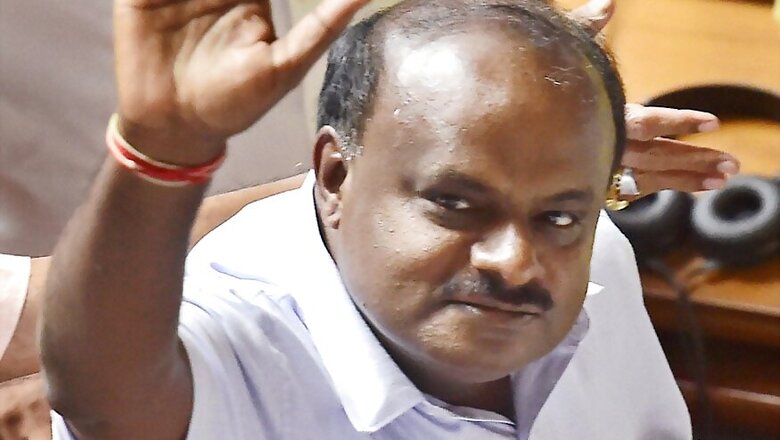
views
New Delhi: The BJP’s failure to form a government in Karnataka has come as a silver lining for the opposition parties ahead of 2019 Lok Sabha elections. Now, perhaps, in a possible show of unity, several prominent Opposition leaders and chief ministers will be sharing the podium at the swearing-in ceremony of Janata Dal (Secular)’s H D Kumaraswamy as Karnataka chief minister in Bengaluru on Wednesday.
The event will also be used as an opportunity by the Opposition to showcase its strength as parties are now setting sight on the equations ahead of the 2019 Lok Sabha elections.
The ceremony will be participated by two main Opposition heavyweights, UPA chairperson Sonia Gandhi and Congress president Rahul Gandhi.
Bahujan Samaj Party (BSP) supremo, Mayawati is also set to travel to Bengaluru to attend Kumaraswamy’s oath-taking ceremony. Delhi Chief Minister Arvind Kejriwal has also confirmed his attendance, as did Kerala Chief Minister Pinarayi Vijayan. Other politicians include West Bengal chief minister Mamata Banerjee, CPI(M) chief Sitaram Yechury, former Uttar Pradesh CM Akhilesh Yadav, RJD leader Tejashwi Yadav, NC’s Farooq Abdullah, DMK chief M. Stalin, and actor-turned-politician Kamal Haasan.
Podium For A Federal Front?
The swearing-in of Kumaraswamy as the chief minister of Karnataka, seen as the convergence of the Opposition to take on the BJP in 2019, might as well be the emergence of an alternate front that can give BJP a fight.
The representatives of the political parties, which will be present at the podium, together form more than 40% of the vote share which these parties got during the 2014 Lok Sabha elections in which BJP came first with 31% of the vote share. The BJP’s vote share then had translated into 285 seats for them. Currently BJP has 274 Lok Sabha seats.
The Opposition leaders present at the event also represent more than 157 seats together. This includes heads of parties like Congress which has 48 seats, All India Trinamool Congress (AITC) with 34 seats, Telugu Desam Party (TDP) with 16 seats, Telangana Rashtra Samithi (TRS) with 11 seats, Communist Party of India (Marxist) (CPIM) with nine seats, and other regional party heads which together take the tally to 157.
TMC president and West Bengal chief minister Mamata Banerjee who will also be present at the ceremony, is already one of the driving forces of the proposed anti-BJP front.
Another important leader present at the ceremony would be BSP chief Mayawati. She also is seen as a potential claimant for the prime minister’s post, following her alliance for upcoming Lok Sabha elections with Akhilesh Yadav of the Samajwadi Party in Uttar Pradesh, which elects 80 MPs.
The Athematic That Can Hurt BJP
The 2014 results showed just how fragmented the vote was: BJP's 31% was the lowest vote share of any party to win majority in the Lok Sabha elections. So, can this convergence of different political parties, in an attempt to consolidate the fragmented vote, have an effect on the outcome of the 2019 Lok Sabha election?
The two big leaders present at the swearing-in are Mayawati and Akhilesh. Their alliance is mathematically a winner. Together the two parties command over 50 per cent of the state's vote share across Yadavs, Jatav Dalits and Muslims. In 2014, the BJP won 71 of the state's 80 seats. The BSP was wiped out and SP won five seats with Congress just the two.
However, following the success of their one-off alliance in Gorakhpur and Phulpur, the BSP and SP can ensure to keep the BJP at bay. This alliance can damage the BJP's seat tally in 2019 significantly.
What also needs to be understood is that in 2014, the BJP got 42.63% of votes in Uttar Pradesh and the BSP, SP and Congress parties combined got 49.83%. Now that all three parties might form a grand alliance in the state, which in turn cannot fragment their vote share, can it doom the BJP’s 2019 prospects?
Other important rallying force present at the ceremony would be West Bengal CM Mamata Banerjee. AITC’s Mamata Banerjee currently has 34 of Lok Sabha seats out of state’s 42 under her party's control. In 2014 elections, the party had supported neither the BJP nor the Congress. However, this time around, Mamata is being touted as the main face of the Opposition. Her comprehensive win in 2014, which consolidated her stature amongst the main opposition parties, might be another reason for the BJP to worry about.
The Anxious Allies
Party heads from Uttar Pradesh and West Bengal is not the BJP's only worry. Maharashtra accounts for the second largest number of Lok Sabha seats: 48, and in 2014, the BJP-Shiv Sena alliance swept 41 seats. BJP won 23 seats and Shiv Sena 18.
The Shiv Sena has already announced that it will contest the 2019 election separately and an embittered Sena poses a serious challenge to the BJP's chances of repeating its 2014 landslide in the state.
Uttar Pradesh and Maharashtra, between them account for 128 seats in the Lok Sabha. The BJP-led NDA won 114 of those 128 seats in the 2014 Lok Sabha poll. Now, these two biggest states can spell danger in Prime Minister Narendra Modi's bid to win a second term in 2019.
While no party leader of the Shiv Sena will be present at the swearing-in, N. Chandrababu Naidu of the TDP might be present there. The party, in 2014 had got 2.55% of the total vote share and had won 16 seats. Back then it was part of the BJP-led National Democratic Alliance but in March this year walked out of the alliance over special category status of Andhra Pradesh. TDP’s joining of the opposition has further solidified the chances of Opposition in the upcoming Lok Sabha elections.
New Forces Join Hands To Take On BJP?
The launch of actor Kamal Haasan’s new party Makkal Needi Maiam (MNM) in Febraury, in itself, might not have been a marker of immediate electoral significance, but his plunge into politics can Challenge BJP in 2019. Now, among all the leading political leaders from anti-BJP parties that have been invited to present a symbolic unity of strength against the saffron party, Kumaraswamy has also extended invitation to Kamal Haasan.
Earlier, Haasan's tweet after Yeddyurappa's failed attempt to come to power without the required numbers was seen as a sign that he could join hands with other anti-BJP parties for the 019 elections.
"Let the democratic light born in Karnataka spread all over the country. Long live Bharatham the grand sacred country," Haasan had tweeted.
Haasan’s inclusion in the swearing-in ceremony also raises a pertinent question: is there a southern electoral axis in the making that can take on the BJP?



















Comments
0 comment